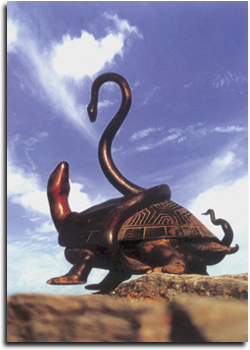
Caption: The fossilized shell of Cerrejonemys wayuunaiki measured about 1 meter across and was about 35mm thick.
Credit: Edwin Cadena
Usage Restrictions: Credit: E. Cadena
Posted on 04/06/2010 10:57:43 AM PDT by decimon
The discovery of a new fossil turtle species in Colombia's Cerrejón coal mine by researchers from the Smithsonian Tropical Research Institute in Panama and the Florida Museum of Natural History helps to explain the origin of one of the most biodiverse groups of turtles in South America.
Cerrejonemys wayuunaiki takes its genus name from Cerrejón, and emys—Greek for turtle. Its species name is the language spoken by the Wayuu people who live on the Guajira Peninsula in northeastern Colombia near the mine.
About as thick as a standard dictionary, this turtle's shell may have warded off attacks by the Titanoboa, thought to have been the world's biggest snake, and by other, crocodile-like creatures living in its neighborhood 60 million years ago.
"The fossils from Cerrejón provide a snapshot of the first modern rainforest in South America—after the big Cretaceous extinctions and before the Andes rose, modern river basins formed and the Panama land bridge connected North and South America," explains Carlos Jarmillo, staff scientist at the Smithsonian who studies the plants from Cerrejón.
"We are still trying to understand why six of this turtle's modern relatives live in the Amazon, Orinoco and Magdalena river basins of South America and one lives in Madagascar," explains Edwin Cadena, first author of the study and a doctoral candidate at North Carolina State University. "It closes an important gap in the fossil record and supports the idea that the group originated near the tip of South America before the continent separated from India and Madagascar more than 90 million years ago."
Cadena will characterize two more new turtle species and analyze the histology of fossil turtle bones from the Cerrejón site. "I hope this will give us an even better understanding of turtle diversity in the region and some important clues about the environment where they lived."
###
The Smithsonian Tropical Research Institute, headquartered in Panama City, Panama, is a unit of the Smithsonian Institution. The institute furthers the understanding of tropical nature and its importance to human welfare, trains students to conduct research in the tropics and promotes conservation by increasing public awareness of beauty and importance of tropical ecosystems. Web site: www.stri.org.
The Smithsonian Paleobiology Endowment Fund, the Florida Museum of Natural History, the U.S. National Science Foundation, the Florida Museum of Natural History Miss Lucy Dickinson Fellowship, the Fondo para la Investigacion de Ciencia y Technologia Banco de la Republica de Colombia, and Carbones de Cerrejon supported this study, published in the Journal of Vertebrate Paleontology.
Ref: Cadena, Edwin A., and Jonathan I. Bloch and Carlos A. Jaramillo. "New Podocnemidid Turtle (Testudines: Pleurodira) from the Middle-Upper Paleocene of South America." Journal of Vertebrate Paleontology 30.2 (2010): 367-382
Congress ping.

Caption: The fossilized shell of Cerrejonemys wayuunaiki measured about 1 meter across and was about 35mm thick.
Credit: Edwin Cadena
Usage Restrictions: Credit: E. Cadena
Mass hysteria!
It’s not uncommon at all for diamondback rattlers to live with gopher tortoises here in FL. You always pay attention when you see a tortoise den to make sure the other half of the odd couple isn’t nearby without you realizing it.
Answers to ‘Hillary’


“New” species? Shouldn’t that be “old” species?
The whole idea of “new fossils” is intriguing.
|
|
|||
Gods |
Thanks decimon. |
||
|
· Discover · Nat Geographic · Texas AM Anthro News · Yahoo Anthro & Archaeo · Google · · The Archaeology Channel · Excerpt, or Link only? · cgk's list of ping lists · |
|||

Tasted like chicken, but no trace has been found of the enormous container of slaw and mashed taters.
Disclaimer: Opinions posted on Free Republic are those of the individual posters and do not necessarily represent the opinion of Free Republic or its management. All materials posted herein are protected by copyright law and the exemption for fair use of copyrighted works.